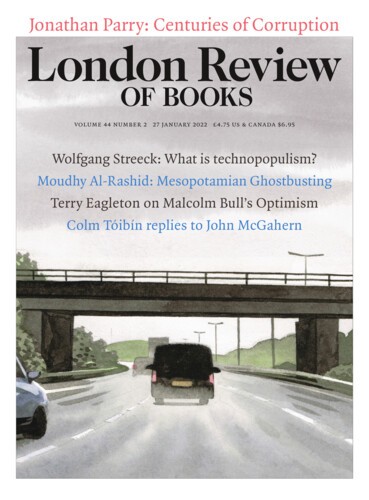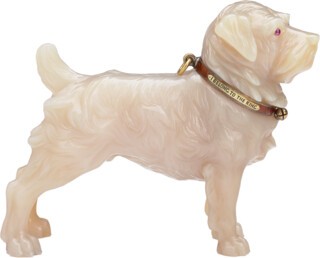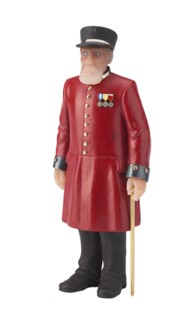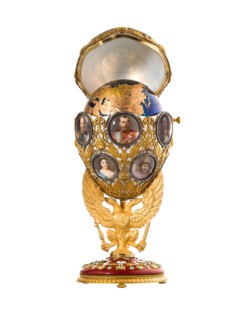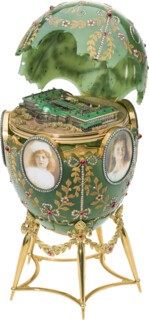In the first room of the new Fabergé exhibition at the V&A (until 8 May), there is a display case containing a pinkish columnar table-portrait of Tsar Nicholas II. It is made of variegated gold, in laurels and garlands, with a gold double-headed eagle on top and a gold frame, accommodating more huge diamonds than one would think permissible or even possible, encircling a vague-looking Nicholas and culminating in a crown. It sits on little gold feet. The eagle is wearing a little gold crown. According to Fabergé in London: Romance to Revolution (£40), published by the V&A to coincide with the exhibition, the portrait was created by the imperial jewellers to mark the occasion in 1909 when Nicholas and Kaiser Wilhelm met on their respective yachts in the Gulf of Finland – one man reaching across the royal blue water to hand the other man a diamond-studded portrait of himself, heavy and spiky enough to be used as a lethal weapon.
The objects in the neighbouring cabinet are restrained in comparison. Tsarina Alexandra’s prayer book, for example, made of dark green nephrite, its surface like the aerial photograph of a river. It is decorated with gold clasps and gold edging on the pages, and was given to Alexandra by Nicholas on the day of their coronation. In another cabinet, the enamel blue cigarette case with a portrait of Tsarevich Alexei at the centre, created by the House of Fabergé to celebrate the birth of the heir to the throne, engraved with gold and dotted with diamonds, which cluster around the watercolour portrait of the baby prince. Above the cabinets are large portrait photographs of the Romanovs in studiedly casual poses, inviting the viewer to imagine them engaged in activities other than the giving and receiving of precious metals: at the beach, chopping wood, looking at the camera with an approximation of playfulness.
Despite the predominance of imperial paraphernalia at the entrance, the curatorial focus of the show is on Fabergé’s London branch, which was enthusiastically embraced by Edwardian society. We’re told that Fabergé’s creations were taken up by Edward VII’s circle because they were ‘not intrinsically valuable’ and therefore unlikely to compromise the giver. It is difficult to square this assertion, which is repeated throughout the show, with the number of diamonds blinking out at visitors. Objects are arranged to illustrate the tastes and habits of different types of Fabergé customer and, per the catalogue, ‘the joyful world in which Fabergé’s British venture thrived’. A gold bootlace hook dotted with diamonds and too delicate to be used for its intended purpose; an enamel scent bottle in the form of a well-dressed baby; a silver elephant automaton with rubies for eyes, ivory tusks and diamonds crowded along the edges of the gold and green enamel rug on which the mahout would sit. Lots of pretty things that might be described as ‘cunning’ by an Edith Wharton character. A little box in the shape of a piano, a cigar cutter in the shape of a fish, a match striker in the shape of a toad, a tiny pink Cinderella carriage with rock crystal windows, gold-stemmed chrysanthemums, a powder puff in the shape of a Fabergé egg.
The British aristocracy are represented by a goose made of obsidian onyx with gold feet, a shire horse with diamond eyes and a chalcedony model of Edward VII’s favourite dog, Caesar, with ruby eyes and a gold collar enamelled to look like leather. There are kangaroos and koalas and cigarette cases in the king’s racing colours and, bewilderingly, a ‘composite hardstone sculpture of a Chelsea pensioner’, with sapphire eyes, the last Fabergé purchase Edward made before he died. There is the cigarette case that Alice Keppel gave to Edward, red gold overlaid with royal blue enamel, engraved with a diamond snake holding its tail in its mouth. Two little owls on a gold branch staring at each other with ruby eyes. An astonishingly lifelike quartz pig with her ear pinned to the ground and her diamond eyes half-closed in exhaustion. The catalogue notes approvingly that ‘compared to the contemporary fashion for extravagance, the queen’s taste in Fabergé was restrained’, though it concedes that despite the ‘strict price range’ stipulated for royal gifts, the queen did find it in herself to accept some of the more expensive items, including a sculpture of flowers in a rock crystal vase with gold stems and diamond centres, presented to her by a Russian diplomat.
And then there is the ‘War, Revolution and Exile’ room, ominously lit up in red and displaying the House of Fabergé’s efforts to respond to the change of mood brought about by the advent of the First World War: silver and brass bowls and cigarette cases with the word ‘WAR’ stamped on them. On the opposing wall, a screen plays footage of Russian soldiers ‘trudging across the snow’, British soldiers ‘advancing across the snow’, the tsarina and her daughters tending to the wounded, as well as footage from the revolution (a column from the Times announcing the execution of the Romanovs, Bolsheviks distributing propaganda, Lenin in Red Square, Russian peasants snapped at by starving dogs), and writings and photographs documenting the end of Fabergé. There is a letter from Carl Fabergé’s son to the firm’s London agent describing his father’s death of ‘a broken heart’ in Lausanne, after the firm was nationalised by the Bolsheviks. The catalogue gives ‘the tragedy of war and revolution’ as the reason for its demise.
Finally, the room with the Imperial Eggs, objects so freighted with symbolic significance that it is surprising to find they are objects at all, even though they are what everyone has come to see. Alexander III gave the first of the Imperial Easter Eggs to Tsarina Maria in 1885, and after his father’s death Nicholas II continued the tradition. Two eggs every year at Easter – one to his mother and one to his wife. Fabergé made fifty eggs in all, and the whereabouts of 43 of them are known today. Fifteen are on display at the V&A, blinking and glittering under a mirrored ceiling. They are condensed versions of wealth, in the same way that an actual egg is a condensed version of food. They are objects to be stolen in heist films, fitting easily into a pocket and requiring no exposition, because even children can see that these things are worth enormous amounts of money. Perhaps they learn about them the way I did, from the episode of the Simpsons where Jimbo and Kearney are stealing suitcases at the airport baggage carousel. They open one up to find it is full of ‘fruity Easter eggs’. In Ocean’s Twelve, a Fabergé egg is stolen twice. In Octopussy, Roger Moore takes part in the auction of a substandard imitation of the Coronation Egg, which is set on one end with a large portrait diamond, surrounded by other diamonds, through which a monogram of the tsarina can be seen. Inside the egg is a precisely rendered miniature of the coach that carried Alexandra to her coronation, with rock crystal windows and platinum tyres and diamond imperial eagles on either door.
The eggs are shorthand for hysterical opulence, an easy target, so that even someone as patrician as Nabokov, from his deckchair on the eastern shore of Lake Geneva, could dismiss them as grotesque. They are toys that children can’t play with, objects of pure whimsy that must be handled with utter seriousness, embarrassingly over-the-top trifles made for unembarrassable people. They are punchlines about fragility and excess, or the most recondite in-jokes imaginable, heavy with meaning that is legible only to the recipient, who is an empress and who is sitting on a throne in the Winter Palace looking at her present through a gold magnifying glass, opening up the enamelled outer shell of a golden egg to find a golden yolk inside, and inside that a little gold hen with ruby eyes, and inside that a jewelled replica of her crown, with a ruby pendant egg. She is opening up another egg, which contains a model of the Trans-Siberian railway, a tiny train with a diamond headlamp pulling tiny carriages with tiny signs that say ‘Mail’ and ‘Chapel’. She is trying to hide her disappointment when she opens the Fifteenth Anniversary Egg and discovers that it contains no surprise at all, contrary to her husband’s instructions. She watches as her mother-in-law opens the Bay Tree Egg, and turns the little key hidden among the leaves so that a little gold bird pops out, opening its little gold beak to sing.
For Geza von Habsburg, a Fabergé expert and the author of the concluding essay in the catalogue, they are ‘the most extraordinary group of jewelled objets d’art ever to be commissioned’, masterpieces that ‘herald, as in a Greek tragedy, the relentless approach of the oncoming tragic final act’. They are fetish objects, or status symbols, or currency, or economic injustice. They are some of the strangest things I have ever seen, enclosed worlds within enclosed worlds, complex riddles whose answer is always ‘money’.
There is the Moscow Kremlin Egg, modelled on the cathedral where the tsars were crowned, with tiny windows you can peer into and a music box that plays Nicholas’s favourite hymn. There is the Rock Crystal Peacock Egg, which opens up to reveal a golden peacock on a golden tree: when you wind him up his gold tail feathers fan out. The Romanov Tercentenary Egg, crawling with gold eagles and emblazoned with portraits of the eighteen Romanov rulers, which opens to reveal a globe showing the extent of the Russian Empire, mapped out in gold and blue. The green Alexander Palace Egg, with a model of the Romanovs’ favourite residence. The Colonnade Egg, the Third Imperial Egg, the Cradle with Garlands Egg, the Blue Serpent Clock Egg with a gold snake slithering up one side, telling the time with its tongue. The Green Egg, latticed with diamonds and containing a tiny wind-up ivory elephant. The Winter Egg, the Mosaic Egg, the Basket of Flowers egg: miraculous feats of invention and energy that are in the end hard to admire, or even to look at for long. And there, to the right, the Swan Egg: enamelled matte lilac, looped with diamond ribbons. The surprise inside is a swan that only looks silver – it’s gold underneath – which sits on a pool of gold lily pads. If you wind it up, the swan’s gold feet move to guide it on its course to nowhere, back and forth in its little pool, in its egg, in its room, in its palace.
Send Letters To:
The Editor
London Review of Books,
28 Little Russell Street
London, WC1A 2HN
letters@lrb.co.uk
Please include name, address, and a telephone number.
